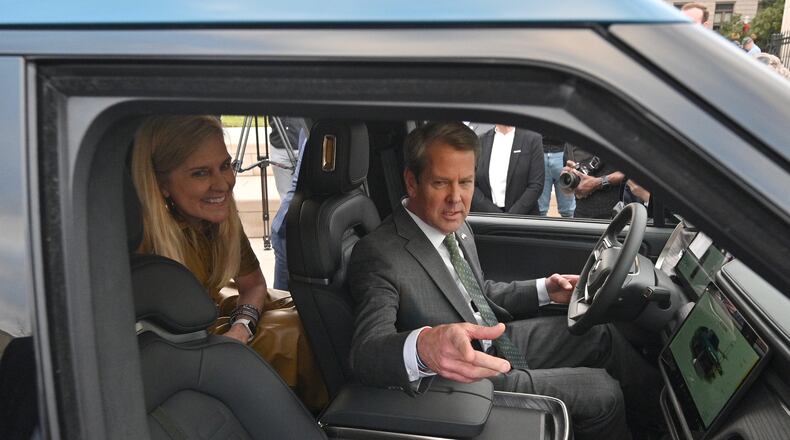State and local officials promised electric vehicle maker Rivian nearly $1.5 billion in tax breaks and other incentives to build a factory east of Atlanta, the most lucrative package of inducements Georgia has ever offered for what Gov. Brian Kemp calls the largest economic development project in state history.
The record package includes free land, a state-owned training center, a new interchange along I-20 between Social Circle and Rutledge and a bounty of local and state tax breaks.
In exchange, Rivian committed to create 7,500 jobs and transform a nearly 2,000-acre tract straddling Walton and Morgan counties, documents released Monday show. The signed agreement paves the way for site development to start this summer, state Economic Development Commissioner Pat Wilson said.
State officials say the eye-popping commitment of public resources is crucial for a generational opportunity to create high-tech manufacturing jobs at the planned $5 billion plant and ensure Georgia claims its spot in the electrified future of the automotive industry. It’s unclear how many states pitched Rivian, but Texas was another finalist for the project.
“It’s very competitive for excellent projects, and this is an excellent project,” Wilson said. “The return on this (investment) is the people whose lives are changed.”
At full buildout, the wages of Rivian workers could total about $420 million per year, Wilson said.
But critics contend Rivian, a well-funded startup, is a risky bet. Rivian faces tough competition from entrenched giants like Tesla, Ford and General Motors. It’s also grappling with logistics challenges worsened by global supply chain problems.
And the project has faced intense local pushback from a grassroots network of nearby residents who say that Kemp and other state officials neglected to get buy-in from residents surrounding the area, about an hour east of Atlanta.
The fallout has also unexpectedly factored into Kemp’s campaign for a second term as former U.S. Sen. David Perdue, the governor’s main GOP rival, framed the public incentives as a naked election-year ploy conducted in the “dark of night” and said he would have nixed the project.
Credit: ArLuther Lee
Credit: ArLuther Lee
Kemp and his allies have maintained what officials from both parties often say after a mammoth deal is struck: It was Georgia’s talented workforce, quality of life and pro-business reputation that helped cement the agreement — and that incentives were just a sweetener.
During Sunday’s Atlanta Press Club debate, Kemp said the same sorts of incentives were used in 2006 to bring the Kia auto plant to West Point when Sonny Perdue was governor.
The $400 million-plus package for Kia in today’s dollars would be worth about $570 million.
The result, Kemp added, is “great-paying jobs going to rural Georgia.”
New details
The full details of the package emerged Monday, months after the project was announced at a celebratory press conference at the state Capitol. The timing comes just after Kemp and Perdue completed their third and final televised debate.
By far the biggest piece of the package involves a $700 million-plus local tax abatement approved by county officials, according to a state offer letter.
The state also agreed on a $21 million direct grant for the project, along with nearly $90 million for a Quick Start training center and job recruitment program. Another $111 million will be spent on land and grading for the project.
State officials committed to spend about $30 million on a new I-20 interchange and roughly $20 million on nearby road and rail improvements. About $7.3 million will be spent to reduce the environmental impact on nearby wetlands and streams.
Some of the most generous perks in the deal were spelled out in Georgia law, including about $200 million from a recently-altered “mega tax credit” program that offers incentives at $5,250 per job annually for five years for companies readying major investments in Georgia.
Other incentives written into the law include tax breaks worth $105 million for construction material and $175 million for the plant’s machinery.
Rivian must fulfill 80% of its jobs and investment promises by the end of 2028 and hold them through 2047, or else be subject to state claw back provisions, state documents show, with annual compliance checks. Much of the package requires Rivian invest or produce jobs before those incentives can be claimed, Wilson said.
Some of the local property tax revenue abated will be recouped by schools and local governments under a payment in lieu of taxes (PILOT) agreement reached last week. Wilson said the local communities and schools will see more than $300 million in PILOT payments from Rivian over 25 years, and after that time the property will be taxed at full value.
The land where Rivian will build its plant currently generates about $80,000 in tax revenue annually. Rivian will pay increase to $1.5 million annually in PILOT fees for six years starting in 2023, increasing to $12 million in the seventh year. PILOT fees will grow to $20 million a year by 2044.
Mike Conrads, who owns a business in nearby Madison, called Rivian “a wonderful thing” for the region, provided the state can fulfill its promises to protect groundwater and build and maintain roads and other infrastructure needed to support future growth.
“One of the issues is kids grow up and there’s no place to work and they move away,” he said.
A big bet
California-based Rivian is making a big bet that Georgia can overcome an extremely tight labor market to help slake its thirst for talent. An offer letter states Rivian jobs will pay on average $56,000 a year, about 42% higher than the median manufacturing wage in Georgia.
The company will need not only automotive engineers but software engineers, information technologists and a new breed of assembly line worker with the technical chops to keep largely automated assembly lines humming.
Credit: Curtis Compton / Curtis.Compton@
Credit: Curtis Compton / Curtis.Compton@
Rivian is likely to pull workers from Augusta, metro Atlanta and even out of state. The state is also counting on the Rivian recruitment to help attract suppliers and help Georgia’s existing supplier network transition to an electrified future.
State and local officials are placing a major wager, too, by committing a trove of public resources on a startup likely to burn through billions of dollars in investor capital over the next several years.
Kasia Tarczynska, a senior research analyst at left-leaning incentives watchdog Good Jobs First, said states like Georgia strike generous deals in secret without public input.
“Job creation and investment is extremely important. But with that, (Rivian) will bring people, development and kids in schools,” she said. “Every development comes with growth. That needs to be paid for. It’s so important for companies to pay their fair share.”
High-tech deals, like Wisconsin’s now-ruined grand dreams for Foxconn, don’t always succeed. But if successful, Rivian could help the state retain high-achieving graduates and spur an economic boom in a rural stretch between Atlanta and Augusta.
Wilson said the state and local expenditures will help Rivian bring its products to market faster.
“Ultimately their speed to market and long-term success benefits the state of Georgia,” he said.
Some local residents worry the plant will upend their rural way of life, bringing more traffic and development. Chas Moore, a local opposition leader who owns an auto repair shop, said it’ll be harder for him to hire workers.
“We’re subsidizing a private industry that’s going to be in direct competition with us,” he said. “If this company is sitting on so much cash, why are the Georgia taxpayers funding it?”
Rivian has said it plans to begin production in 2024 at the Georgia plant, where it eventually expects to be able to manufacture up to 400,000 vehicles a year.
Cox Enterprises, owner of The Atlanta Journal-Constitution, also owns about a 4% stake in Rivian and supplies services to the company. Sandy Schwartz, a Cox executive who oversees the AJC, is on Rivian’s board of directors and holds stock personally. He does not take part in the AJC’s coverage of Rivian.
Staff writer Michael E. Kanell contributed to this report.
Recruiting Rivian
The state of Georgia released details Monday of the incentive package offered to woo electric vehicle maker Rivian to build a plant an hour east of Atlanta where it will employ 7,500 workers. Some details:
- $701.7 million in local property tax abatements
- $196.9 million for mega job tax credit
- $105 million for construction materials tax exemption
- $175 million for machinery tax exemption
- $111 million for land and grading for the project
- $62.5 million for a Quick Start training center, plus $26.9 million for customized recruitment and training programs
- At least $51.5 million for I-20 interchange local road improvements
- $21 million direct grant from the state
- $7.4 million for wetland and stream mitigation
Sources: State offer letter and executive summary of incentive deal
Our Reporting
The AJC first reported Georgia’s recruitment of EV maker Rivian and in December broke the story that Rivian had selected the Peach State over other suitors. The future Rivian factory will likely have profound effects on the communities of Social Circle and Rutledge in the years ahead, and the AJC will closely follow developments as the project moves forward.
Keep Reading
The Latest
Featured






